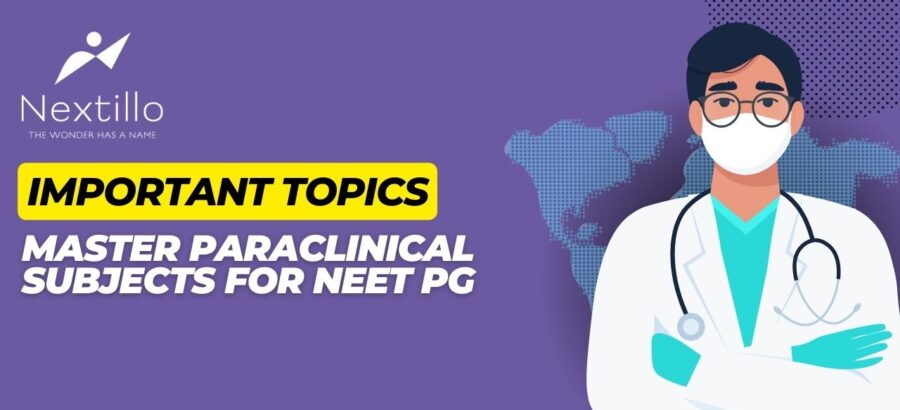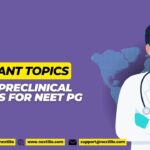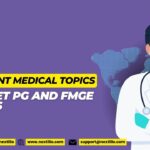Preparing for the NEET PG exam can be daunting due to the extensive syllabus. Nextillo’s guide highlights essential topics in para-clinical subjects that are crucial for the exam. Mastering these topics will provide a solid foundation and streamline your preparation.
Important Topics of Pathology for NEET PG
List of high yield and most important topics from Pathology for the NEET PG exam:
| Subject | High Yield Topics from Pathology |
| Cell Injury & Inflammation | Patterns of cell injury, free radical damage, pigmentation, cellular events in inflammation, chemical mediators, granulomatous inflammation |
| Neoplasia & Malignancy | Genetic mechanisms of cancer, tumor markers, diagnostic techniques, Molecular hallmarks of cancer, bone tumors, melanoma, Hodgkin & Non-Hodgkin lymphoma, seminoma |
| Hematology | Coagulation pathway, hemophilia, blood banking, megaloblastic anemia, multiple myeloma, iron deficiency anemia, sickle cell anemia, hemolytic anemia, lymphoma, hypercoagulability, thalassemia, acute leukemias (AML/ALL), CML & MDS, Waldenstrom’s disease, heavy chain disorders, paroxysmal nocturnal hemoglobinuria |
| Genetics & Immunology | Modes of inheritance, diagnostic techniques for genetic disorders, hypersensitivity reactions, granuloma, complement pathway, immunodeficiency disorders, amyloidosis, gene repair defects, Down syndrome, Turner syndrome, TNR disorders, single-cell disorders, specific cytogenetic disorders |
| Gastrointestinal Pathology | Jaundice, fatty liver, hepatitis, ulcerative colitis, celiac disease, Whipple’s disease, GI polyps, liver disorders, inflammatory bowel disease, peptic ulcer disease, acute and chronic gastritis, GI tumors, congenital GIT anomalies, mesothelioma |
| Renal Pathology | PSGN, diabetic nephropathy, ADPKD, renal cell carcinoma, glomerular nephritis, nephrotic syndrome, Alport syndrome, renal spotters, renal stones |
| Cardiovascular Pathology | Myocardial infarction, dilated and hypertrophic cardiomyopathy, aortic aneurysm, rheumatic heart disease, vasculitis, infective endocarditis, vascular sclerosis, bleeding disorders, clotting factor disorders, blood transfusion, blood grouping, platelet disorders |
| Respiratory Pathology | ARDS, emphysema, TB lung lesions, adenocarcinoma, occupational lung diseases, obstructive lung disorders, pulmonary hypertension, infective lung disorders, lung abscess, neonatal respiratory distress syndrome, lung cancer, COPD, asbestosis |
| CNS Pathology | Brain malformations, CSF analysis, prion diseases, medulloblastoma, meningioma, CNS degenerative diseases, meningitis, CNS tumors, neuroblastoma |
| Endocrine Pathology | Papillary thyroid carcinoma, follicular carcinoma, pheochromocytoma, parathyroid disorders, thyroid disorders, adrenal gland disorders, diabetes |
| Breast Pathology | Fibroadenoma, breast oncogenesis, breast cancer, TNM staging |
| Miscellaneous | Aging, Marfan & Ehlers-Danlos syndromes, transplantation, HIV, hypertension, diabetes, and amyloidosis |
Important Topics of Microbiology for NEET PG
List of high yield and most important topics from Microbiology for the NEET PG exam:
| Subject | High Yield Topics from Microbiology |
| General Microbiology | History, Staining Techniques, Culture Media, Sterilization Techniques, Bacterial Cell Wall, Bacterial Growth Curve |
| Bacteriology | Staphylococcus, Streptococcus, Corynebacterium, Bacillus, Clostridium, Enterococcus Family, Mycobacterium, Pseudomonas, Haemophilus, Brucella, Bordetella, Yersinia, Vibrio, Chlamydia, Rickettsia, Mycoplasma, Helicobacter, Campylobacter, Listeria, Legionella, Neisseria, Staph Toxins, Legionella case scenario, Typhoid toxins, Lab tests and toxins for E.coli, Salmonella, Cholera, and Pseudomonas, Lab investigations for Tuberculosis, Case-based questions on Leptospira and Brucella |
| Virology | General properties of viruses, Classification of viruses, Herpes, Pox, Rabies, Polio, Adenovirus, Hepatitis, HIV, Influenza (Antigenic shift vs drift), Dengue, Hepatitis B serology tests, Opportunistic infections in HIV, AIDS-related infections and management, Types and infections of Herpes group, Recent updates in Virology |
| Mycology | General properties, Classification of Fungi, Dermatophytes, Endemic Mycoses, Cryptococcus, Madura Mycosis (case-based and radiology), Candida, occupational fungal diseases, Dermatomycosis, and dimorphic fungi |
| Parasitology | Entamoeba, Giardia, Plasmodium, Leishmaniasis, Taenia solium, Hymenolepis nana, Ascaris, Wuchereria, Schistosomiasis, Image-based questions on Malaria, Stages of Malaria, Transmission and host for Amoebiasis, Giardiasis, Nematodes, Trematodes, Toxoplasmosis, Stages of Neurocysticercosis in Cysticercosis, Haemoflagellates, Coccidian Parasites, Cestodes, Images of eggs of all parasites |
| Immunology | Antigen- Antibody, Antigen-antibody reactions (examples), Hypersensitivity reactions (examples), Graft versus host disease (GVHD), Autoimmunity, Immunoglobulins, and immunodeficiency disorders |
| Miscellaneous | Aging, Marfan & Ehlers-Danlos Syndromes, Transplantation, HIV, Hypertension, Diabetes, and Amyloidosis |
Important Topics of Pharmacology for NEET PG
List of high yield and most important topics from Pharmacology for the NEET PG exam:
| Subject | High Yield Topics from Pharmacology |
| General Pharmacology | Route of Drug Administration, Bioavailability, Plasma Protein Binding, Pharmacovigilance, Microsomal enzymes and Enzyme Induction, First pass metabolism, Kinetics of Elimination, Loading dose and Maintenance Dose G protein-coupled receptors, Therapeutic index, Factors modifying drug actions, Placebo, Rational prescribing, Tolerance, and teratogenicity |
| ANS | Basic architecture and functions of the divisions of ANS, Uses of cholinergic drugs, Management of OP, Carbamate and atropine poisoning, Drugs acting at neuromuscular junction, Drugs used in myasthenia gravis and Alzheimer’s disease, Atropine and glycopyrrolate, Drugs used in bladder conditions (overactive bladder and BPH), Adrenaline, noradrenaline and dopamine in detail, Receptors of the sympathetic and parasympathetic system, AChe inhibitors, including OP poisoning, Uses of anticholinergic drugs and poisoning, Used of adrenaline, noradrenaline, and dopamine, Beta-blockers (cardioselective vs. non-selective), Contraindications of beta blockers, Prazosin uses and adverse effects, Anti-glaucoma drugs, Anti-obesity drugs |
| Autacoids | Difference between first- and second-generation antihistamines, Drugs for Migraine (attack and prophylaxis), Antihistaminics (1st vs 2nd generation), Antihistamine causes QT prolongation, Prostaglandin preparation and uses, Contraindications of Prostaglandin preparations, 5HT receptors, and NSAIDs: PCM and aspirin in detail, Drugs for gout (acute vs. chronic), Drugs for RA, and DMARDs (mainly mechanism of action) |
| Renal Pharmacology | Mechanism and site of action of diuretics, Adverse effects of loop, thiazides and spironolactone, DOC in various edema conditions, Contraindications of mannitol, Tolvaptan, Uses of desmopressin and terlipressin |
| CVS | Difference between ACE inhibitors and ARBs, Reasons for angioedema and dry cough with ACE inhibitors, Contraindications of ACE inhibitors, Drugs decreasing mortality in chronic CHF, Basic concepts and drugs in acute and chronic CHF, Digoxin in detail, Nesiritide, Nitrates mechanism of action in angina, Nitrates plus sildenafil, Calcium channel blockers (DHPs vs. Non-DHPs), Newer drugs in Angina pectoris, First line antihypertensive drugs, Drugs used in hypertensive crisis, Antihypertensive drugs mechanisms and major adverse effects, Antihypertensive drugs contraindicated in pregnancy, Drugs used in pulmonary hypertension, Classification of anti-arrhythmic, DOC for various arrhythmias, Amiodarone in detail, particularly adverse effects, Nitrates, New drugs for angina, Mechanisms and names of anti-arrhythmic drugs, Statins and new anti-dyslipidemic drugs |
| Endocrine | Bromocriptine, cabergoline, Uses of octreotide, Drugs used in acromegaly, Uses of GnRH agonist and antagonists Uterine relaxants and stimulants, Propylthiouracil and carbimazole differences Insulin preparations, Metformin, in detail, Anti-diabetic drugs-MOA, effect on glucose, weight, and routes of administration, SGLT2 Inhibitors adverse effects, Teduglutide, Sotagliflozin, tripeptide and Saroglitazaar Adverse effects and contraindications of corticosteroids, Steroids use in preterm labor and CAH, Drugs to treat Cushing disease, Bisphosphonates-MOA, USES, and A/E), Bone forming and resorbing agents, Drugs used for BPH, Erectile dysfunction, premature ejaculation, and prostate cancer, Selective Estrogen Receptor Modulators (SERMs), Selective Estrogen Receptor Downregulators (SERDs), Tamoxifen, Aromatase Inhibitors, Clomiphene Citrate, Mifepristone, and Osteoporosis. |
| CNS | Differences between benzodiazepines and barbiturates, Benzodiazepines and liver disease, Management of benzodiazepines and barbiturates poisoning, Orexin antagonists and melatonin agonists, Types of seizures and DOC, Valproate, phenytoin, carbamazepine, topiramate, and lamotrigine in detail Mechanism of action of anti-epileptic drugs, Drugs in alcohol, smoking, and opioid de-addiction, Lithium in detail, the difference between typical and atypical antipsychotic, Adverse effects of typical antipsychotics, particularly extra-pyramidal symptoms and management, Clozapine, risperidone, and Aripiprazole in detail Drugs used in Parkinson’s, Alzheimer’s, Huntington’s and amyotrophic lateral sclerosis, Advantages and disadvantages of levodopa and carbidopa combination, SSRIs use and adverse effects, Antidepressants causing sexual dysfunction, Morphine uses, contraindications and poisoning, Morphine vs. Pethidine, Tramadol and Methadone Characteristics Drugs for neuropathic pain |
| Hematology | basic mechanism of antiplatelet drugs, Newer oral anticoagulants, Warfarin and Heparin, Drugs affecting blood and blood formation, Mechanism of action of anticoagulants, adverse effects, antidotes, and lab monitoring, Anticoagulants in pregnancy, NOACs/DOACs, Mechanism of action of antiplatelet drugs, Clopidogrel and CYP2C19, Management of acute and chronic iron overdose, Fibrinolytics and Antifibrinolytics, Statins, Fibrates, and Niacin: Mechanism, Uses, and Adverse Effects. |
| Respiratory System |
Drugs for asthma prophylaxis and acute attacks, Montelukast, Omalizumab, and Cromoglycate: Mechanism of Action, Bronchodilators, Adverse effects of Salbutamol, New drugs in asthma and COPD, Drugs used in Dry and productive cough, Bronchial Asthma
|
| GIT | Metoclopramide and dystonia management, DOC for CINV, Morning sickness and motion sickness, PPIs – MOA, and uses H.pylori eradication regimen |
| Antimicrobials | Mechanisms of action of antibacterial drugs, Major bacterial infection (DOC/First choice), Anti-bacterial: cidal and static, Adverse effects of antibacterial drugs, Anti-bacterial is safe in pregnancy, children and renal failure, Drugs used in STIs and prophylaxis, First line anti-TB drugs in detail (HRZE), Bedaquiline in details, Second line TB drugs, Definition of MDR, pre XDR and XDR TB, Leprosy treatment regimen and management of lepra reactions List of ineffective antimicrobials in certain infections, Metronidazole in detail, DOC for Helminthic infections, Mechanisms of antifungals and DOC for systemic fungal infections, MOA of oseltamivir, Drugs used for COVID management, DOC for HSV, VZV, CMV, Hepatitis B and C, MOA and adverse effects of anti-HIV drugs, Treatment and prophylaxis of HIV and treatment of opportunistic infection in HIV patients, Malaria treatment and prophylaxis, Chloroquine, primaquine in detail |
| Anticancer and IS | Cell cycle and non-cell cycle-specific anticancer drugs, Detailed study of cyclophosphamide, cisplatin, 5-fluorouracil, and vincristine, detailed study of methotrexate, Small molecule inhibitors and monoclonal antibodies in anticancer therapy, Immune checkpoint inhibitors in anticancer therapy, Mechanisms of action of immunosuppressant drugs, Calcineurin inhibitors, Adverse effects of cyclosporine |
| Miscellaneous | Treatment of Hyperkalemia, Tricyclic antidepressants, and antidotes of various drugs |
| Chemotherapy | Mechanisms of drug action and Drug resistance, Methods of drug resistance, Mechanisms of resistance, Superinfection and concentration-dependent killing, Drugs Inhibiting Cell wall synthesis, Penicillin, Cephalosporin, Other beta-lactams, Beta-lactamase, Drugs inhibit Protein synthesis, Chloramphenicol, Tetracycline, Macrolides, Aminoglycosides, Lincosamides, Streptogramins, Antimetabolites, Fluoroquinolones, Miscellaneous, Sulphonamides, Trimethoprim, Cotrimoxazole, Urinary antiseptics, Other antibiotics, Antimycobacterial Antibiotics, Antitubercular Drugs, Treatment of tuberculosis, Antileprotic Drugs, Antifungal Antibiotics, Classification, Systemic Drugs for superficial fungal infections, Topical Drugs for superficial fungal infections, Antiviral Antibiotics, Classification, Anti herpes drugs, Anti-influenza drugs, Antihepatitis drugs, Anti-HIV drugs, ART, anti-malarial drugs, The Cycle of Malaria, Antimalarial Regimen, Malarial Prophylaxis |
| ANS, Blood, and Endocrinal Drugs | Parasympathomimetics, Autonomic nervous system introduction, Parasympathetic nervous system and receptors, Function of the cholinergic system, Parasympathomimetic drugs, Parasympatholytics, Anticholinergic Drugs, Actions of antimuscarinic drugs, Adrenergic drugs, Sympathetic nervous system, Actions |
Important Topics of Forensic Medicine for NEET PG
List of high-yield and most important topics from Forensic Medicine for the NEET PG exam
| Subject | High Yield Topics from Forensic Medicine |
| Legal Procedure | Inquest system, Court types, Evidence and its exceptions, Oath, Dying Declaration vs. Dying Deposition, Duties of a doctor as a witness, Capital Punishment |
| Medical Law and Ethics | Functions of MCI and SMC, Professional Misconduct vs. Negligence, Privileged Communication, Consent (types, exceptions), Res Ipsa Loquitur, Euthanasia, Health-related declarations, Relevant acts (Transplantation of Human Organs Act, Consumer Protection Act, Medical Termination of Pregnancy Act, Protection of Children from Sexual Offenses Act, The Mental Healthcare Act) |
| Identification | Age, Race, and Sex determination, Hair analysis, Dactylography, Teeth, Poroscopy, Anthropometry, Cephalic index, Intersex, Gustafson’s method, MLI of scars and tattoos |
| Autopsy | Autopsy techniques, Types of Autopsies, Embalming, Preservation of Viscera, Artefacts, and exhumation |
| Thanatology | Suspended Animation, Signs of Death (Algor Mortis, Rigor Mortis, Changes in Eye, Post-Mortem Hypostasis, Putrefaction, Adipocere, Mummification), Criteria of Death, Entomology, Death Certificate, Brain stem death |
| Injuries | Abrasions, Contusions, Lacerations, Incised and Stab Wounds, Firearm Injuries, Thermal Injuries (Burns, Electrocution, Lightening), Range of Firearms, Bullet types, Bomb Explosion Injuries, Fabricated wounds |
| Burn Injuries | AM vs PM Burns, Post Mortem Changes, Burn Classification, Electrocution, Lightning Injuries |
| Forensic Psychiatry | Delusion, Hallucination, Impulse, Psychosis vs. Neurosis, Lucid interval, Schizophrenia, Testamentary capacity, Section 84 IPC, Somnambulism |
| Sexual Offences | Virginity, Pregnancy, and Delivery indicators, Classification of Sexual Offenses, Section 375 IPC, Punishment under Section 376 IPC, Examination of rape victim, Locard’s Exchange Principle, Sodomy, Tribadism, Sexual Paraphilias, and Seminal Stains test |
| Asphyxia | Causes/Classification, Lynching, Hanging vs. Strangulation, Cafe Coronary Syndrome, Drowning examination, Diatom test, Sexual Asphyxia |
| Death/Thanatology | Rigor Mortis, Cadaveric Spasm, Heat Stiffening, Order of Putrefaction, Mummification, Brain Stem Death, Cause and Mode of Death, Sudden Death, Tache Noire |
| Infanticide and Child Abuse | Hydrostatic test, Causes of Infant Death, Shaken Baby Syndrome, Live born vs. Stillborn identification, Hydrostatic test |
| Toxicology | Section 284 IPC, Poison Classification, Organophosphorus Poisoning, Alphos Poisoning, Vitriolage, Chronic Arsenic Poisoning, Hydragyrism, Phossy Jaw, Sui, True vs. Artificial Bruises, Ophitoxemia Signs, Snake Poisoning, Section 85 IPC, Widmark’s Formula, LSD, and Date Rape Drugs |
| Others | Post-mortem artifacts, Transportation Injuries, Confirmatory Blood Tests, and medico-legal Application of Blood Groups |
Read more:- Master Preclinical Subjects for NEET PG: Important Topics
Nextillo App:
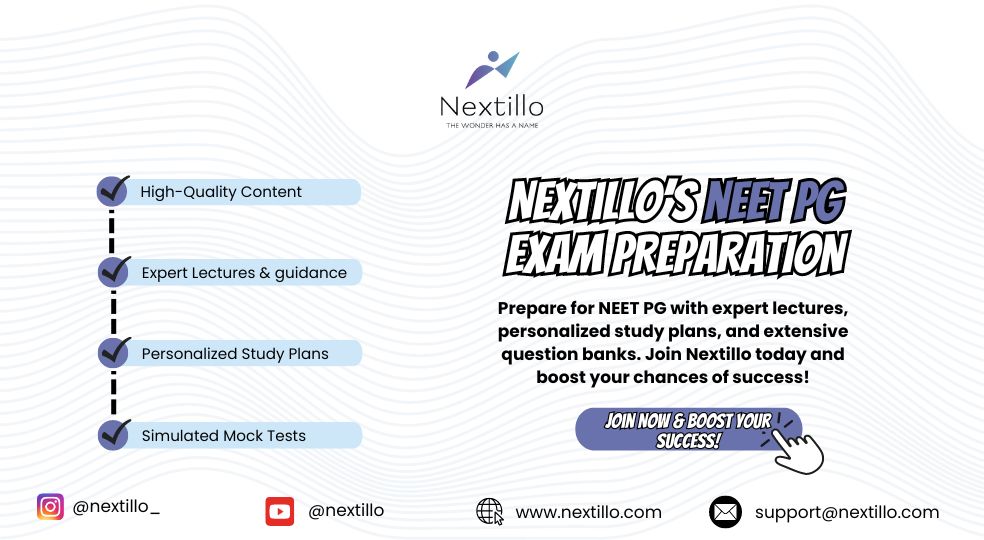
Nextillo is an online platform dedicated to helping students prepare for the FMGE and NEET PG exams. Nextillo provides a comprehensive range of study materials covering all 19 subjects required for these exams, including:
- Video Lectures: Concept-Based Video lectures for FMGE and FMGE thoroughly cover the entire syllabus in detail.
- Notes: Concise and highly detailed Study material for FMGE and NEET PG for quick revision.
- Previous Year Question Papers: Access to past FMGE and NEET PG previous year question papers to help with practice and understanding exam patterns.
- Vast Study Material: A wide range of resources are designed to guarantee comprehensive preparation for these exams.
Summary
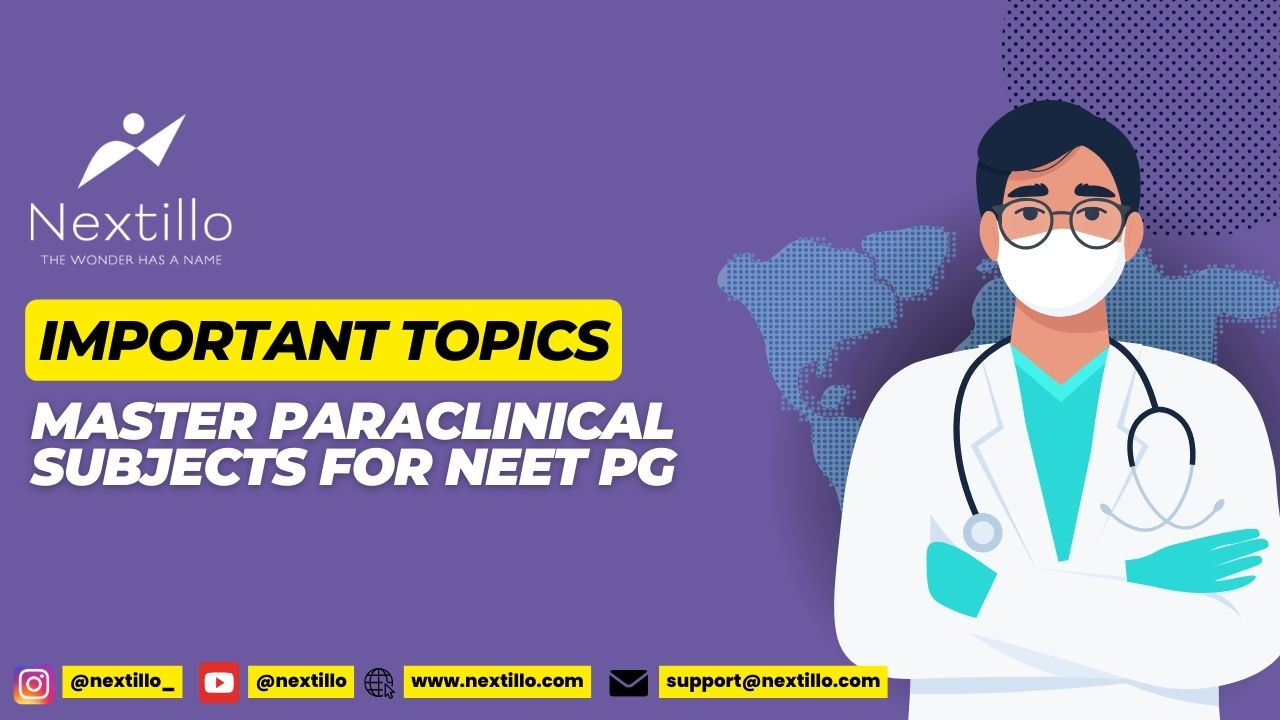
Article Name
Master Paraclinical Subjects for NEET PG: Important Topics
Author
Dr.Bhanu
Publisher Name
Nextillo
Publisher Logo




